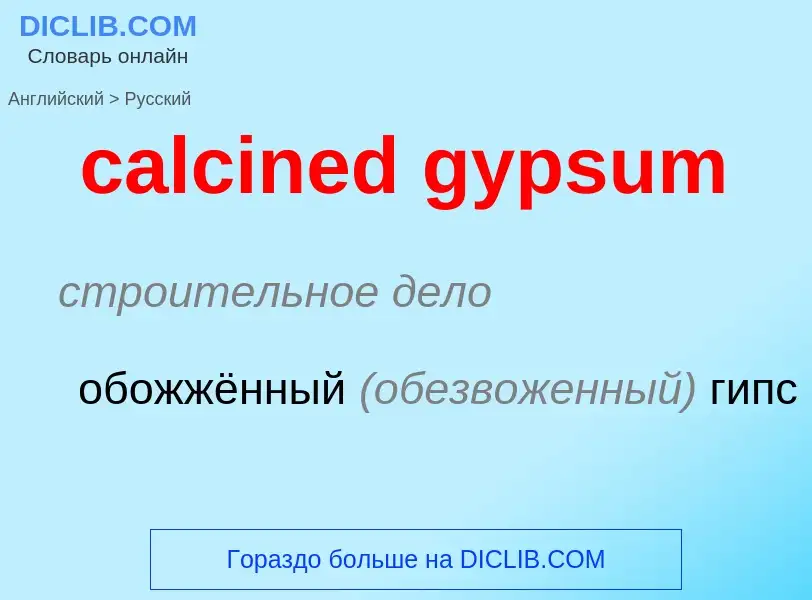Translation and analysis of words by ChatGPT artificial intelligence
On this page you can get a detailed analysis of a word or phrase, produced by the best artificial intelligence technology to date:
- how the word is used
- frequency of use
- it is used more often in oral or written speech
- word translation options
- usage examples (several phrases with translation)
- etymology
calcined gypsum - translation to russian
строительное дело
обожжённый (обезвоженный) гипс
Definition
Wikipedia

Plaster is a building material used for the protective or decorative coating of walls and ceilings and for moulding and casting decorative elements. In English, "plaster" usually means a material used for the interiors of buildings, while "render" commonly refers to external applications. Another imprecise term used for the material is stucco, which is also often used for plasterwork that is worked in some way to produce relief decoration, rather than flat surfaces.
The most common types of plaster mainly contain either gypsum, lime, or cement, but all work in a similar way. The plaster is manufactured as a dry powder and is mixed with water to form a stiff but workable paste immediately before it is applied to the surface. The reaction with water liberates heat through crystallization and the hydrated plaster then hardens.
Plaster can be relatively easily worked with metal tools and sandpaper and can be moulded, either on site or in advance, and worked pieces can be put in place with adhesive. Plaster is suitable for finishing rather than load-bearing, and when thickly applied for decoration may require a hidden supporting framework, usually in metal.
Forms of plaster have several other uses. In medicine, plaster orthopedic casts are still often used for supporting set broken bones. In dentistry, plaster is used to make dental models by pouring the material into dental impressions. Various types of models and moulds are made with plaster. In art, lime plaster is the traditional matrix for fresco painting; the pigments are applied to a thin wet top layer of plaster and fuse with it so that the painting is actually in coloured plaster. In the ancient world, as well as the sort of ornamental designs in plaster relief that are still used, plaster was also widely used to create large figurative reliefs for walls, though few of these have survived.


![An [[orthopedic cast]] for the hand made out of plaster. An [[orthopedic cast]] for the hand made out of plaster.](https://commons.wikimedia.org/wiki/Special:FilePath/Cast extended.jpg?width=200)

![Clay plaster base coat on split oak lath held in place with straw and manure, covered with a lime plaster top coat, [[Old Economy Village]], Pennsylvania (1827) Clay plaster base coat on split oak lath held in place with straw and manure, covered with a lime plaster top coat, [[Old Economy Village]], Pennsylvania (1827)](https://commons.wikimedia.org/wiki/Special:FilePath/Clay plaster ceiling.jpg?width=200)
![''[[Himeji Castle]]'', [[Himeji]], [[Hyogo Prefecture]], [[Japan]] ''[[Himeji Castle]]'', [[Himeji]], [[Hyogo Prefecture]], [[Japan]]](https://commons.wikimedia.org/wiki/Special:FilePath/Himeji Castle The Keep Towers.jpg?width=200)
![John Cranch]] (1751–1821) John Cranch]] (1751–1821)](https://commons.wikimedia.org/wiki/Special:FilePath/John Cranch - Plasterer - Google Art Project.jpg?width=200)
![House of Borujerdies]] in [[Kashan]], [[Iran]] House of Borujerdies]] in [[Kashan]], [[Iran]]](https://commons.wikimedia.org/wiki/Special:FilePath/Gachbori kashan.jpg?width=200)
![Face plaster casting [[bandage]] application Face plaster casting [[bandage]] application](https://commons.wikimedia.org/wiki/Special:FilePath/Face plaster cast application.jpg?width=200)

![''Seated Voltaire''; by [[Jean-Antoine Houdon]]; 1778; plaster, tinted to imitate terracotta; overall: 35.6 × 14.6 x 20 cm (14" × 5¾" × 8"); Metropolitan Museum of Art ''Seated Voltaire''; by [[Jean-Antoine Houdon]]; 1778; plaster, tinted to imitate terracotta; overall: 35.6 × 14.6 x 20 cm (14" × 5¾" × 8"); Metropolitan Museum of Art](https://commons.wikimedia.org/wiki/Special:FilePath/Seated Voltaire MET DP105166.jpg?width=200)
 MET DP370292.jpg?width=200)

![new Louvre]]; circa 1856; Metropolitan Museum of Art new Louvre]]; circa 1856; Metropolitan Museum of Art](https://commons.wikimedia.org/wiki/Special:FilePath/Édouard Baldus, Plaster Model of an Ornamental Oeil-de-Boeuf for the New Louvre, ca. 1856.jpg?width=200)

![Portland]], US) Portland]], US)](https://commons.wikimedia.org/wiki/Special:FilePath/The Young Mother by Bessie Potter Vonnoh, c. 1896, plaster - Portland Museum of Art - Portland, Maine - DSC03949.jpg?width=200)
